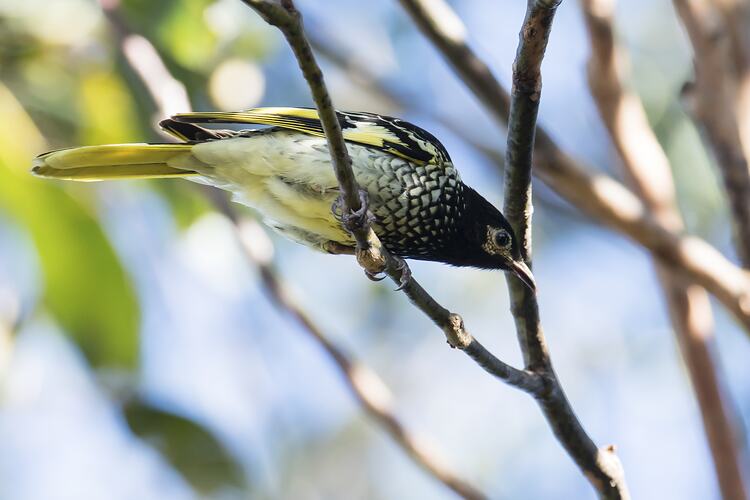General Description
It has a black head, neck and upper breast, a yellow back and breast scaled black, with the underparts grading into a white rump; black wings with conspicuous yellow patches, and a black tail, edged yellow. The male has yellowish warty bare skin around the eye. The female is smaller, with a bare yellowish patch under the eye only, and has less black on the throat. Body size is up to 23 cm.
Biology
Strongly nomadic, following flowering Eucalypts. It feeds mainly on nectar and other plant sugars, but will also feed on insects and spiders, and native and cultivated fruits. It forages in flowers or foliage, but sometimes comes down to the ground to bathe in puddles or pools, and may also hawk for insects on the wing. Its call is quiet and melodious but it can also mimic larger honeyeaters. It is badly affected by land-clearing, with the clearance of nectar-producing trees and the poor health of many remnants, as well as competition for nectar from other honeyeaters. It is listed federally as an endangered species. At the state level, it is listed as endangered in Queensland and New South Wales, while in Victoria it is listed as threatened.
Distribution
South-eastern Australia.
Habitat
Eucalypt forests and woodlands, particularly in blossoming trees and mistletoe.
More Information
-
Animal Type
-
Animal SubType
-
Brief Id
Black head, yellow back, black wings with yellow patches.
-
Colours
Black, White, Yellow
-
Maximum Size
23 cm
-
Habitats
-
Diet
Omnivore
-
Diet Categories
Nectar, Insects, Spiders
-
Endemicity
-
Commercial
No
-
Conservation Statuses
CITES: Not listed, EPBC Act 1999: Critically Endangered, IUCN Red List: Critically Endangered, FFG Threatened List: Critically Endangered
-
Taxon Name
-
Scientific Author
(Shaw, 1794)
-
Common Name
Regent Honeyeater
-
Kingdom
-
Phylum
-
Subphylum
-
Class
-
Order
-
Family
-
Genus
-
Species Name
phrygia

